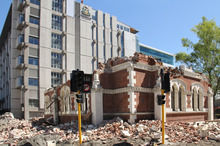However, the West Coast Regional Council today moved to reassure the public, saying the Alpine Fault was a far more imminent threat.
The National Institute of Water and Atmospheric Research (Niwa) led the two-year mapping project for the council, which wanted to assess the tsunami risk for coastal communities.
Niwa marine geologist Philip Barnes said while the faults were relatively large and capable of causing fairly severe earthquakes, it was thought they had extremely long recurrence intervals, meaning that large earthquakes would be very infrequent.
Dr Barnes said the oil industry had been active off the West Coast and had collected a lot of data about some of the faults over several decades.
"However, this is the first time the offshore data has been analysed to determine whether these faults are active and the potential earthquake hazard they pose."
The report says:
- The faults run parallel to the coast, within 30km of the shore.
- There are 10 marine faults in the 320km between Cape Farewell in the north, to Hokitika in the south. These include five segments of the Cape Foulwind fault, the Kahurangi and Kongahu faults (Karamea), and three others referred to informally as the Farewell, Elizabeth (Rapahoe), and Razorback (Punakaiki) faults.
- The faults range in length from 10km to 120km and are expected to generate earthquakes ranging in magnitude from 6.4 to 7.8.
- It is estimated earthquakes of these strengths would recur on individual faults between once every 7500 to 30,000 years.
"This information will underpin future work to improve the modelling of seismic and tsunami hazards that will help coastal communities and authorities better understand the potential risk associated with future earthquakes."
Regional council planning and environmental manager Michael Meehan said it was important for the council to gauge what it was dealing with, "and to help us decide where to from here".
The West Coast has been the location of two of New Zealand's most severe earthquakes in recent history: the Murchison earthquake in 1929, which measured 7.8 and the 7.1 Inangahua earthquake in 1968. These earthquakes were caused by ruptures on onshore faults that share many similarities with the offshore faults.
Mr Meehan said the Alpine Fault ruptured every 350 years. Compared to that, the risk of the newly-discovered faults rupturing was "quite low".
They now needed to understand what a rupture on the 'new' faults would do - would it generate a tsunami, how large, and where?
The council had secured money and employed Geological Nuclear Sciences (GNS) to start inundation modelling, which would take a few months to complete.
"We need the next piece in the puzzle now, and GNS will help fill in the gaps."




Reader Comments
to our Newsletter